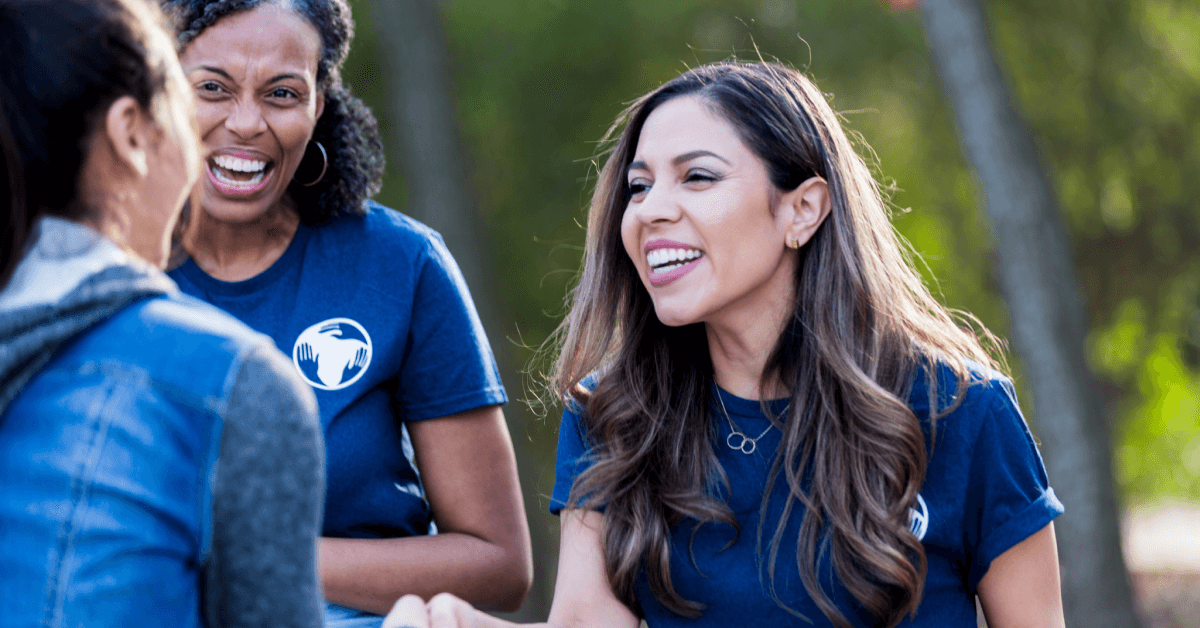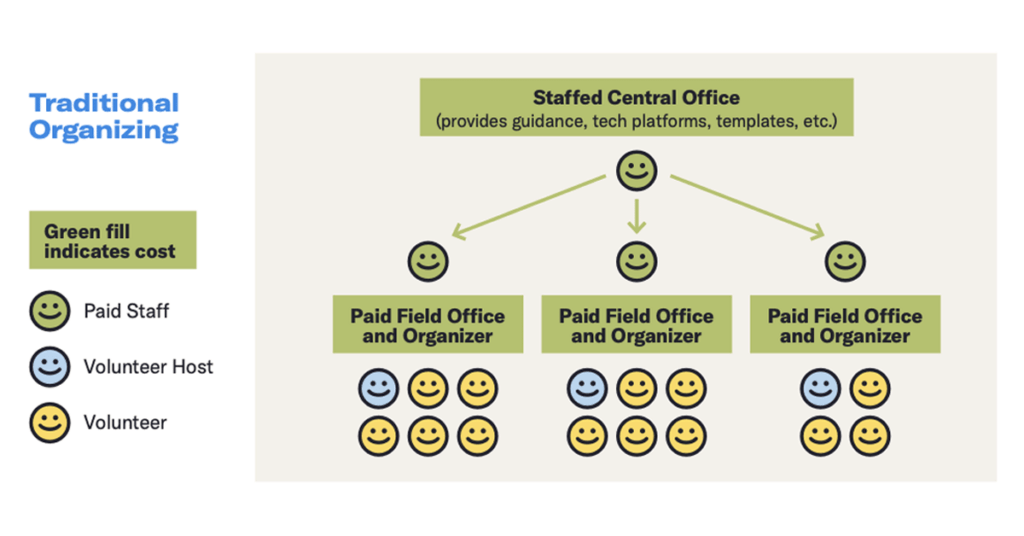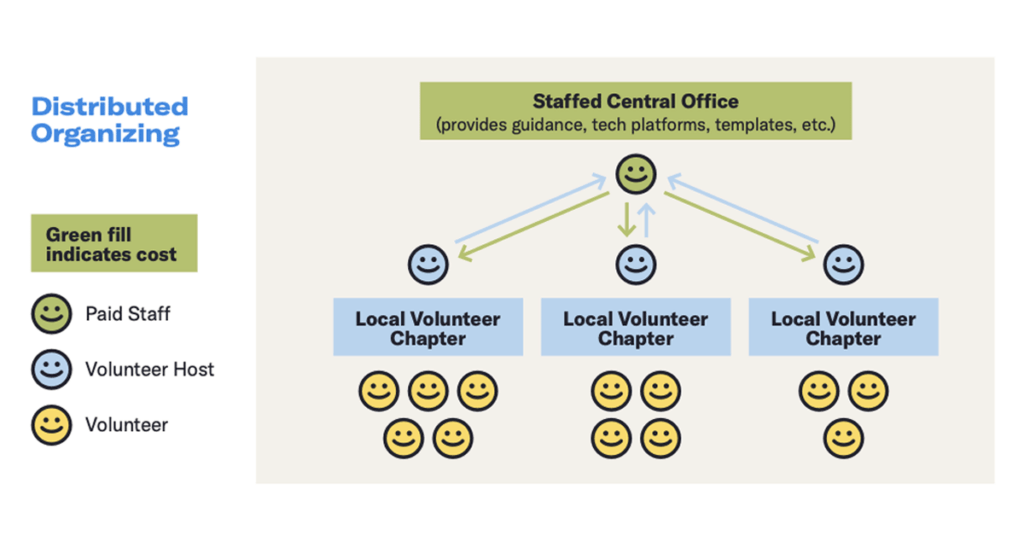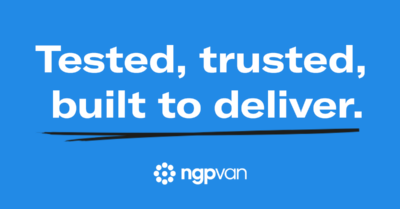A Guide to Distributed Organizing For Political Campaigns

Modern political campaigns are no longer limited to traditional methods of mobilization and top-down decision-making. Distributed organizing models have emerged and given rise to a new era of grassroots activism that can help progressive and Democratic candidates like you win elections and create change in communities big and small nationwide.
In this guide, we’ll explain what distributed organizing is and how it works, as well as its benefits and whether it’s a good fit for your campaign. By providing an overview of distributed organizing, you’ll be able to consider if it’s beneficial for your campaign to leverage it to power your campaign.
Distributed Organizing Definition
A traditional, centralized organizing structure has a clear chain of command with power concentrated in the hands of a few and decisions directed outward from campaign headquarters. In the graphic below, the central office usually pays for field offices and organizers in various areas around the district, state, or country. These organizers are then tasked with recruiting volunteers to help achieve the campaign’s goals. While impactful organizing typically involves a two-way chain of communication, traditional organizing tends to provide direction from the top-down with varying levels of flexibility depending on the campaign.

On the other hand, distributed organizing allows for a more democratic and decentralized decision-making process. This system empowers a broader range of individuals and encourages collective ownership of initiatives and goals. While the central office still provides resources in a similar manner to a traditional organizing model, distributed organizing relies heavily on local volunteer chapters organizing autonomously. The central office relinquishes control (to varying degrees) to these chapters to organize in the communities they know best. This organizing model also tends to focus on fostering greater two-way conversations that help the campaign gather feedback, collaborate with these local volunteers, and suggest strategy adjustments when needed.

How Distributed Organizing Works
The distributed organizing model works by decentralizing campaign activities and empowering “chapters” of volunteers and supporters to play a central role in various campaign efforts. It typically begins with campaign headquarters providing tools, training, and resources to volunteers, enabling them to then organize their chapter’s members to engage in activities such as voter outreach, phonebanking, canvassing, and social media activities.
Volunteer groups operate autonomously, often focusing on their local communities where they can make a significant impact. This approach harnesses the energy and enthusiasm of a network of individuals, expanding a campaign’s reach and grassroots support while fostering a local sense of ownership among volunteers.
The Benefits of Distributed Organizing
Distributed organizing allows campaigns to tap into the energy and enthusiasm of individuals across different regions, reaching demographics and communities that might otherwise be inaccessible through traditional centralized methods. Campaigns only have a limited amount of time and resources, and, when used effectively, this model can allow them to connect with communities that may not have otherwise.
In particular, campaigns can connect with more remote communities or multiple groups across a large district through this model, allowing them to reach more voters. This extended reach can help mobilize a more diverse and widespread support base to help them win their elections.
Plus, organizers on the ground can provide valuable data and feedback from their respective areas, helping you refine your strategy, messaging, and voter targeting in the future.
Determining If Distributed Organizing is a Good Fit For Your Campaign
While distributed organizing offers many benefits, it’s not for everyone. Campaigns that see the most success with this model tend to have:
- An enthusiastic volunteer base: Assess the level of engagement, eagerness, and experience among your supporters. If your volunteer base is well-versed in campaign strategies and excited to contribute, the distributed organizing model can harness their energy effectively to advance toward your organizing goals.
- Resource constraints: This model relies on volunteers’ time and dedication rather than substantial financial investments. As a result, it can be a more cost-effective strategy for campaigns with limited financial resources. However, well-funded campaigns can also harness the power of distributed organizing to advance toward their goals too.
- Local focus: If your campaign relies on building strong local connections and tailoring messages to specific communities or regions, this model can be a good fit, as it allows volunteers to engage directly with their communities, leverage their personal connections, and speak to the needs of local voters.
- Straightforward goals: Distributed organizing works best for campaigns that have a clear and simple goal, like electing a specific candidate to office.
Campaign teams that aren’t comfortable letting go of some level of control to volunteers may find a more traditional top-down organizing model to be the best organizing model for them.
Tips for an Effective Distributed Organizing Model
Distributed organizing programs allow for local autonomy, but they also need structure to succeed. Follow these tips to build an effective model for your campaign.
Write a Mission Statement
A well-crafted mission statement provides a strategic roadmap for the campaign. It helps organizers and volunteers prioritize their efforts and stay focused on activities that directly contribute to the mission’s fulfillment.
The candidate and relevant staff can construct a mission statement by answering the following questions:
- What does our campaign stand for?
- Who do we serve?
- What do we hope to achieve?
- Why should people get involved?
Compile these answers into a clear and concise mission statement that you can share with each campaign chapter. When everyone is on the same page about your purpose, vision, and goals, the campaign’s decentralized activities are more likely to remain coherent and coordinated.
Identify Your Leaders
Volunteer leaders play a crucial role in coordinating and organizing grassroots efforts. Before organizing your program, have one-on-one conservations with volunteers interested in leading specific chapters to ensure they have the experience needed and are ready for the responsibility.
Delegate specific responsibilities that align with their skills and interests. Keep in mind that the work of one paid organizer can often be divided between 3 or 4 dedicated volunteer leaders. Common roles include recruiting other volunteers, leading a team of canvassers or phone bankers, managing a social media group, and organizing community events. Once roles have been assigned, provide training and support to help volunteer leaders excel in their positions.
Add Structure to the Distributed Network
While chapters operate independently in their respective regions, the central office serves as the coordinating hub, ensuring that all chapters align with the campaign’s overarching goals and adhere to standardized protocols. This relationship is characterized by a two-way flow of information, with chapters reporting progress, sharing insights, and seeking guidance from the central office, which, in turn, provides support, resources, and strategic direction.
Establish a framework that chapters can follow to maintain consistency and effectiveness in their activities. These protocols can encompass everything from voter outreach strategies to data management best practices, empowering chapters to operate autonomously while upholding the campaign’s unified vision and contributing toward the campaign’s goals.
Once protocols are established, document them in a centralized location that is easily accessible. This could be a campaign handbook, a dedicated website section, or a shared digital workspace.
Evaluate Your Technology
Launching a distributed organizing campaign requires a strong technical infrastructure. As volunteer leaders and staff take on various initiatives, essential details and data must be communicated.
Consider investing in the following tools to streamline your distributed organizing model:
- Volunteer management software: Volunteer management software helps local leaders streamline the recruitment, training, assignment, and tracking of volunteers. Look for software that offers volunteer sign-up forms, shift scheduling, task assignments, automated communications (email or SMS), and reporting capabilities.
- Virtual meeting tools: Distributed organizing often involves remote collaboration and communication. Virtual meeting tools like Zoom, Microsoft Teams, or Google Meet facilitate real-time interactions and information sharing among volunteers, campaign staff, and leaders.
- Data and analytics platforms: Data is critical for targeting, outreach, and measuring success. CRMs for political campaigns allow teams to access and manage voter and supporter data efficiently. Teams can access a comprehensive database with detailed voter or supporter information, including demographics, voting history, and contact information. They can then upload more information into this database and update existing data for the campaign to use in the future.
The specific tools that campaigns use vary according to their unique size, budget, and needs. For instance, if hosting community events is a large part of your campaign, you may also need to invest in an event management system to track RSVPs to help manage logistics. Based on your overall campaign plan, you should have a solid understanding of what software or tools you need to set your campaign up for success.
Dive Deeper Into Distributed Organizing
While distributed organizing is a relatively new term, its roots in community organizing principles are not. In our webinar with Tectonica, we discuss these community organizing concepts that play significant roles in distributed organizing models, keys to building impactful organizing programs, examples of distributed organizing success, and the technology you can use to support your organizing events and efforts. If you aren’t quite sure this organizing model is right for your campaign, this webinar should help you make the informed decision about moving forward with a distributed or traditional organizing model.
A Final Note About Distributed Organizing
Distributed organizing empowers individuals to become change agents in their communities with your campaign’s guidance, amplifying your message and growing your supporter base through local voter and supporter outreach efforts.
Now that you know how distributed organizing works, you can supercharge your approach with the tools provided by NGP VAN. Trusted by thousands of progressive and Democratic campaign organizers, our software will help you mobilize volunteers, target voters, and effectively manage your distributed organizing campaign.



